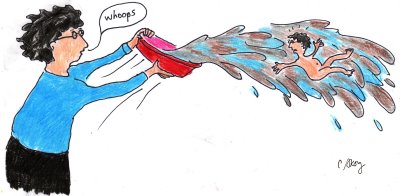After my post last week about the ludicrously low prices that are being charged for ebooks, I decided to try something. I put one of my novels – the first one, ‘A Good Liar’ – onto a four day free offer, starting on April 23rd, which happened to be my birthday.  (Considering my qualms about this method of book promotion, you might call it an ‘unhappy birthday to me’. ) Ever open-minded, I wanted to see what would happen in both the short-term and as a possible more lasting consequence.
(Considering my qualms about this method of book promotion, you might call it an ‘unhappy birthday to me’. ) Ever open-minded, I wanted to see what would happen in both the short-term and as a possible more lasting consequence.
I’ve just checked the figures on my KDP dashboard and 97 free ebook copies of ‘A Good Liar’ have been downloaded in the past two days, 72 on day 1 and 25 yesterday. Will the downward trend will continue over the next two days? Apart from listing the offer, I did nothing more to publicise it. I assume that Kindle have a list of freebies that tight-fisted readers trawl through. It only takes seconds to click and costs them nothing, but then what? Do they actually read the book, or check the first page or two and discard those that don’t appeal?
By the weekend I’ll know the total number of downloads. What I will not know is how many, if any, of these free books were read. I could check the Amazon reviews, but very few readers actually bother to submit anything. I could check hits on the website, or sales of the other books in the series – all of which are still listed at the ‘normal’ price of around £4 – £5. I’d be surprised if a freeloader was prepared to pay that for a book, unless they were so enamoured of the story that they simply had to read on, and that would be great.
My curiosity is piqued. Maybe I should try another experiment, temporarily reducing the cost of one of my books to 99p, to see if that makes the same difference. I could use it as part of the promotion campaign for the new book, which is due in early June. That book will handled by Fahrenheit Press, who have the ebook rights to my crime novels. I’ll be interested to see what their fairly idiosyncratic approach to promotion does to raise reader awareness.
I’ve done ‘loss leaders’ before: in my previous life as an international education consultant I did work ‘pro bono’ sometimes, just to introduce myself to a new client, confident that ‘work generates work’ and that more jobs would follow, and they always did. With book sales I’m less confident that a free offer will produce a lasting effect. That could be because my books are not as good as the contribution I made as a consultant, although I do get a gratifying amount of positive feedback. Or maybe as a relative novice, I just don’t understand how book selling really works.
Fortunately, I don’t expect or need to make a living from writing and publishing my own books, in paperback as well as ebook formats. But I don’t expect to make a loss either. I work hard at my writing and want readers to enjoy the result. I find and pay good people with expertise to edit, typeset, proofread, design the covers and print my books. All those paperback production costs need to be covered, and that depends on the delicate balance of sales and pricing. Conversion to ebook is relatively cheap, but I still don’t want to undervalue the work that goes into my novel, in what ever format. There’s the dilemma.

 Having said that, something seems to depend on the reader. While some readers spot everything, and usually tell you so, others seem not to notice at all.
Having said that, something seems to depend on the reader. While some readers spot everything, and usually tell you so, others seem not to notice at all. It took a while. In my distress I managed to get highlighter on my duvet covet and it has proved impossible to get rid of, reminding me of the miserable business every time the duvet cover appears on my bed.
It took a while. In my distress I managed to get highlighter on my duvet covet and it has proved impossible to get rid of, reminding me of the miserable business every time the duvet cover appears on my bed.
 opening details just a little more I’ll be up to the 85,000 word mark, exactly midway between the parameters suggested by expert colleague. Let’s hope so. I’m getting to the stage now when I never want to see this manuscript ever again.
opening details just a little more I’ll be up to the 85,000 word mark, exactly midway between the parameters suggested by expert colleague. Let’s hope so. I’m getting to the stage now when I never want to see this manuscript ever again. You will need an idea, a setting – time and place – some characters who interest you and a story that hopefully will engage potential readers. Whether you plan in detail or not is your choice, and you also decide when you will write, where, for how long, alone or in collaboration with others. Personally, I do plan – although the plan changes all the time. I write at home, out in the shed if the weather’s good, upstairs if it’s not too cold, and downstairs if I need more warmth. I research and plan for several months before starting the first draft and then I try to write chapters in the order in which they’ll be read. Once I’m writing, the first draft emerges pretty quickly.
You will need an idea, a setting – time and place – some characters who interest you and a story that hopefully will engage potential readers. Whether you plan in detail or not is your choice, and you also decide when you will write, where, for how long, alone or in collaboration with others. Personally, I do plan – although the plan changes all the time. I write at home, out in the shed if the weather’s good, upstairs if it’s not too cold, and downstairs if I need more warmth. I research and plan for several months before starting the first draft and then I try to write chapters in the order in which they’ll be read. Once I’m writing, the first draft emerges pretty quickly. This is where the details of the story are checked to see if they hang together. Does the chronology work? Are there inconsistencies of any kind? Does every chapter/scene add to the story? Does the plot develop in a way that keeps the reader going? I like to get feedback from someone who’s not encountered the story before, beyond the initial outline. The person needs to understand how stories work, to be clear in their judgement and able to provide a critique which is helpful without being bossy – it’s your story, after all.
This is where the details of the story are checked to see if they hang together. Does the chronology work? Are there inconsistencies of any kind? Does every chapter/scene add to the story? Does the plot develop in a way that keeps the reader going? I like to get feedback from someone who’s not encountered the story before, beyond the initial outline. The person needs to understand how stories work, to be clear in their judgement and able to provide a critique which is helpful without being bossy – it’s your story, after all. One of my books slipped through this stage with insufficient attention and I have regretted it ever since – far too many tiny errors that a fast reader wouldn’t even notice but a slow/picky reader did and will. There’s always a kind person out there who will send you the unbearable list of mistakes. The best way to get the proofs properly checked is to have them read by someone with a professional and very picky approach and who has never encountered your story before, at all, ever. Some of the best proof-readers read from back page to front to avoid getting so involved with the story that their reading speed picks up and mistakes are missed. We need proof-readers, even if we might not want to spend the evening with them.
One of my books slipped through this stage with insufficient attention and I have regretted it ever since – far too many tiny errors that a fast reader wouldn’t even notice but a slow/picky reader did and will. There’s always a kind person out there who will send you the unbearable list of mistakes. The best way to get the proofs properly checked is to have them read by someone with a professional and very picky approach and who has never encountered your story before, at all, ever. Some of the best proof-readers read from back page to front to avoid getting so involved with the story that their reading speed picks up and mistakes are missed. We need proof-readers, even if we might not want to spend the evening with them.